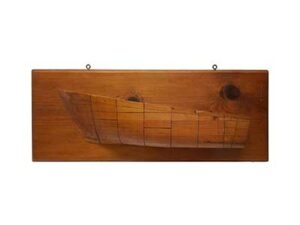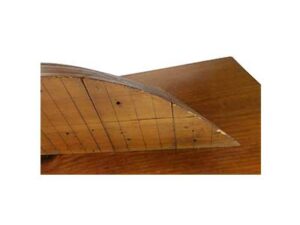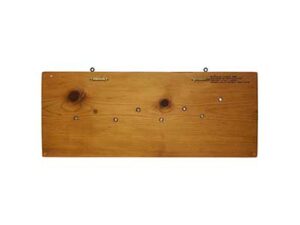Half Hull “Buttocks” Model of Chesapeake Fishing Boat

Dimensions
Backboard: 30 1/4″ x 11 1/4″
Half Model: LOA 23 1/2″ Deck to keel at Bow: 5 1/2″ Deck to Keel at Stern: 3 1/4″
Weight: 9 lbs.
Presented is an unusual antique builder’s half hull model. It was made
to loft the lines of a very unique design of a Baltimore Fishing vessel.. The model is constructed in
a most unusual manner with six lifts of horizontal planks from the waterline to the keel and nine (from bow to stern) vertical sections all of which are held by seven screws through the backboard and are meant to come apart. This treatment combines the classic horizontal method with the rarely seen buttocks method of half hull construction and is one of only two examples we’ve seen. The likelihood is the
model was to be used for a special type of lofting function where the lifts were to match some feature of construction
for taking off templates or dimensions that where better suited to using both vertical and horizontal lifts. The deck
has thirtytwo station markings in pencil which are also incised into the exterior of the hull.
 |
 |
Stern Section Bow Section
 |
 |
Close up of measurment marks on deck
Unfortunately, there is nothing known of the real vessel this model depicts. It is the classic fishing or work boat design with the large high bow and a diminishing top side to the stern, bringing the back working deck closer to the waterline.
Explanation of lofting methods for converting builder’s half hull models to ship construction:
in the designer’s knowledge of which shape produced the fastest and most seaworthy vessel. They are usually made using
multiple layers of wood, stacked one on top of each other on a horizontal plane, called lifts. The lifts were made to
be taken apart, and were used as a template to lay off the lines on the floor. These were then enlarged to the vessel’s
full size in a process that was called “lofting”.
are placed together on a vertical plane, and instead of describing the shape of waterlines, they show the shape of the
vessels buttock’s or cheeks. When translated into an elevation drawing, the buttocks appear as curved lines and the stations
and waterlines appear as straight vertical lines. This is in contrast to a plan view of the vessel’s shape where the waterlines are
shown as curved lines and the buttocks and stations as straight lines.
CONDITION: The half hull shows the hand work of scribed or sawn stations at numberous positions.
The distance between appears equal. It also has the stations incised on the hull exterior. There are a few very small chips of wood missing at the bow at deck level, and there are some minor scratchs consistant with its use and age. The hull
is finished with an appealing stain and has a warm patina.
 |
 |
Back of mounting board showing previous owner and source
On the back of the backboard in the lefthand corner in
block architect style is the name of a gentleman who purchased the Half Hull in June of 2003.
